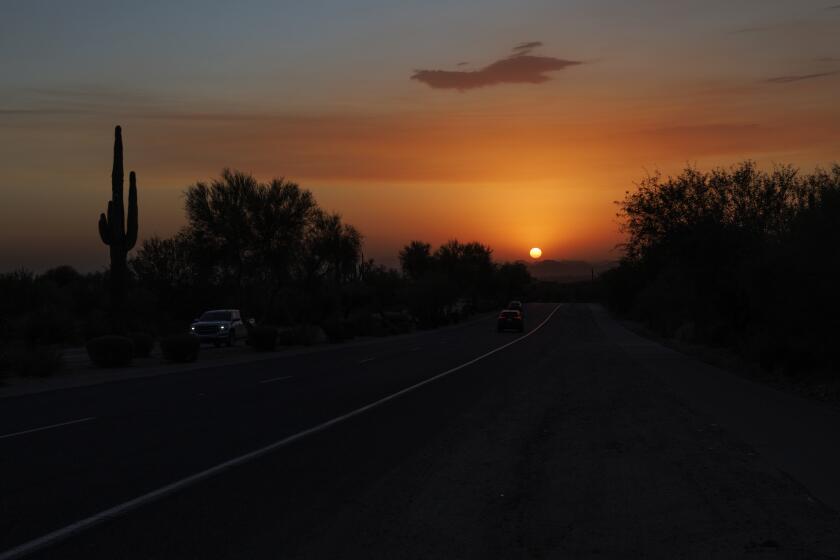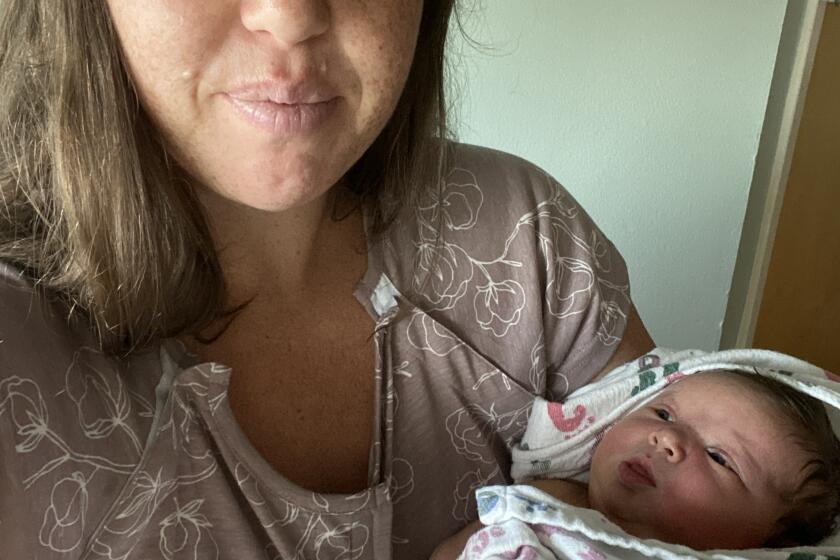What Price Open Space? : Taxes: Newport Beach voters will be asked Nov. 2 to pay $68 million for three parcels of bay view land. Some contend that’s too rich.
As far back as anyone can remember, the voters of Newport Beach have never approved a bond measure for parks.
And that’s just the way many taxpayers in this oceanside city like it.
But if local environmentalists have their way, residents will reject tradition and vote for Measure A, beginning the process of buying three parcels of bay view land that otherwise would be developed.
The price would be high: $68 million, including money to maintain the land in coming years.
Overlooking the Upper Newport Bay, or Back Bay as the locals call it, the Upper and Lower Castaways and Newporter North have been the battlefield over which environmentalists and developers have fought for 30 years. But now, the fight is between environmentalists who want to preserve open space and property owners who believe the price of undeveloped land is too high in this time of rising taxes.
So with a little more than a week until the Nov. 2 election, the two sides are campaigning feverishly on television, at City Hall and in the streets.
The Committee for Measure A--backed financially by a local environmental group, the Newport Conservancy--says that by endorsing creation of an assessment district to buy the bluff-top parcels, residents would preserve open space for future generations. Furthermore, the supporters say, property owners in all parts of the city would reap environmental, property value and recreational benefits.
“The things that make Newport Beach such a wonderful place--the ocean, the harbor, the wonderful views--would be blocked by condominiums if we lose this land,” said Robert Shelton, a former Newport Beach city manager who now chairs the Committee for Yes on Measure A.
“This is our last and only chance to save these properties,” Shelton added. “The time is right and the price is affordable.”
The Newport Beach Taxpayers Alliance, the Newport Harbor Area Chamber of Commerce and other property owners argued that the $68-million price tag is too high to pay for land, 60% of which they would have gotten free anyway.
That’s because the Irvine Co. has plans to build a 71-slip marina on Lower Castaways, 151 homes on 26 acres of Upper Castaways and 212 homes on 30 acres of Newporter North. The remaining 78 acres would be preserved as open space for the city to maintain as stipulated in the Circulation Improvement and Open Space Agreement signed late last year by the city and the Irvine Co.
“Why would the city want us to take on a 30-year assessment in these times of bad economics when they get practically the same thing without any taxes at all, I just don’t understand,” said Ed Benson, a 22-year resident of the city.
Richard Luehrs, president of the local chamber of commerce, said business owners in the city cannot afford any more taxes. “We’re not arguing the merit of this particular land purchase,” he said. “We just don’t think this is the appropriate time . . . nor is it in the community’s best interest right now.”
The Conservancy is led by Councilwoman Jean H. Watt, who founded and serves as president of the nonprofit group. In June she and other Conservancy members persuaded the Irvine Co. to sell the Castaways and Upper Newporter North for $58.3 million, about 20% less than the land’s appraised value. The environmental group then convinced the City Council to place Measure A on the ballot as an advisory vote to gauge taxpayers’ willingness to foot the bill.
The $68-million assessment--about $160 million with interest by the time the bond matures in 2024--would cover $58.3 million in acquisition and $10 million in property restoration and maintenance costs.
If the measure is approved by at least 60% of voters, the City Council could begin forming the Open Space Assessment District to sell $68 million in bonds, which would be used to pay the Irvine Co. in two installments during the next two years. (The 60% figure was set by the City Council to assure that if the measure passed, it had the backing of a solid majority.)
The district would collect up to $120 annually from the owners of all single-family residences in the city for the next 30 years to finance the purchase of the bonds. Apartment and mobile-home owners would be assessed annually at $104 per unit. Commercial property owners would pay $120 annually for every 2,000 square feet of space.
Even if Measure A is passed, taxpayers opposed to the proposal could still overturn the vote if--after two public meetings--property owners whose land make up more than 50% of the city’s area send in written protests. If the measure is snubbed by voters either at the polls or during the written-protest stage, the Irvine Co. likely will begin construction on the properties.
The giant developing company, in the meantime, has kept hands off. Company officials said they are awaiting the election’s results and are “neutral.”
The Conservancy is pushing for the passage of Measure A because, Watt and others say, the open space provided by the Circulation Improvement and Open Space Agreement is not enough. They say the Irvine Co. would develop most of the prime property, leaving mainly the wetlands and bluffs for open space. Moreover, the plan allocates five acres of space for a ball field compared to the 10 acres sought by supporters of Measure A.
As envisioned by supporters of Measure A, if the proposal is passed, the 57-acre Upper Castaways will have wide open spaces, hiking, biking and walking trails and recreational facilities. The privately funded Newport Harbor Nautical Museum will be built on the four-acre Lower Castaways. The more environmentally sensitive 77-acre Newporter North, near the ecological reserve, would remain mostly untouched.
Supporters of Measure A have a tough battle ahead of them to get at least 60% of voters’ approval given the city’s history with park measures.
According to past and present city officials, taxpayers of Newport Beach have never approved a park measure. Two years ago, city officials scrapped plans to buy the Upper Castaways and Newporter North for $82 million when a survey indicated that voters would not go for it. In 1977, a bond measure to preserve open space failed by 1%. In 1972, voters also spurned a bond measure to acquire land from the California Department of Transportation and turn it into parks.
Recognizing past failures, Shelton said, “I think there has been some disappointment. But the circumstances have changed. Prices have come down and community interests have increased.”
Backers of Measure A have promised voters that “all costs are covered” by the assessment which, they added, would not increase over 30 years. However, those opposing the proposal have pointed out that the $68 million does not include the costs of building and maintaining the recreational areas highlighted in the Committee for Measure A’s campaign pamphlets.
Currently, $1.6 million of the city’s general fund is reserved for parks. With or without Measure A, the city eventually would use some of the money to build ball fields on the Upper Castaways.
City Councilman Phil Sansone, an opponent of Measure A, contends that for the Committee for Measure A to keep all of its campaign promises, the city would have to deplete the park fund as well as dig into the city’s general fund to come up with almost $275,000 annually for 30 years to cover maintenance and improvement costs not included in the assessment.
“If the assessment is not going to pay for those hidden, recurring costs, someone is going to have to,” Sansone said. “We don’t have that kind of money in the general fund unless we increase more fees.”
Shelton with the Committee for Measure A called the recreational facilities issue “a misunderstanding.”
“The athletic fields are some of the ideas kicked around . . . a sort of a wish list of things that could happen,” Shelton said. “It was never intended that those improvements come from Measure A.”
Foes of the measure also claim they’ve been lassoed by the Conservancy, which is paying for the $60,000 election, and city officials into possibly paying property taxes against their will. They have accused the majority of the council members of trying to circumvent the law set by Proposition 13, which requires a two-thirds majority before levying property taxes.
Watt, Mayor Clarence J. Turner and Councilwoman Evelyn R. Hart--all of whom have come under blistering attack for serving on the Committee for Yes on Measure A--countered that under the Landscaping and Lighting Act of 1972, they could have gone ahead and set up a collecting district without voters’ approval. The act allows municipal governments to form assessment districts.
By having the advisory vote, residents in the city have a say in what they want to do with the properties facing the Back Bay, supporters argue.
Furthermore, the officials favoring Measure A said, property owners can protest the passage of Measure A under the 1972 act. Under Proposition 13, the tax would have been implemented immediately after passage.
“People keep saying, ‘The city is doing this,’ but it’s not the city that’s going to decide,” said Turner. “It’s the people.”
Besides, Turner and other supporters of Measure A said, the ultimate issue is not what is right or wrong with the proposal, but rather, whether taxpayers are willing to pay for open space.
“The real issue here is does this community want to invest in an everlasting asset for the betterment of Newport Beach?” asked Shelton. “That’s the real issue: Is it worth it?”
Correspondent Bob Elston contributed to this story.
Prime Parcels Approving Measure A would cost Newport Beach taxpayers $68 million in bonds for three pieces of land.
More to Read
Sign up for Essential California
The most important California stories and recommendations in your inbox every morning.
You may occasionally receive promotional content from the Los Angeles Times.










